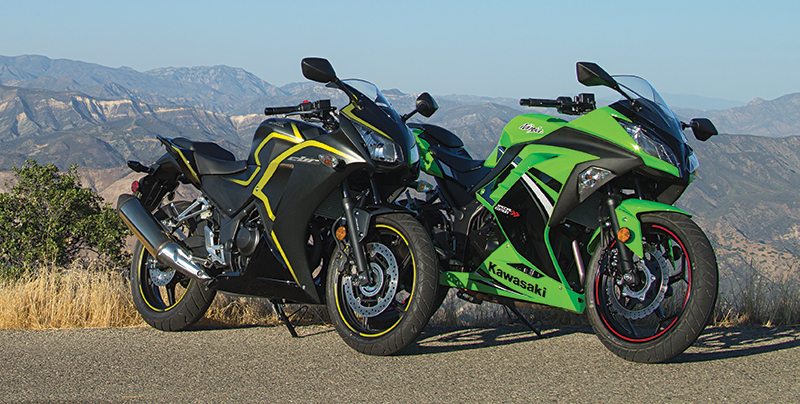
It was only a matter of time. In the face of Honda’s 2011 CBR250R challenge to its long-lived Ninja 250, Kawasaki embarked on a top-to-bottom improvement program that resulted in a bigger, badder little Ninja. Touching almost half of the engine parts, Kawasaki added 50 more cubes by way of a 7.8mm stroke increase, plus long-awaited digital fuel injection to the parallel twin for 2013. Aware that it may have awakened a 296cc monster, the Kawi crew also beefed up the tranny to handle the extra punch wrought by the engine work. And with a nod to fuel economy, it reduced the compression ratio a full point to 10.6:1, allowing the Ninja to run regular unleaded fuel. Faced with a more powerful foe, Honda had no choice but to open the CAD files, take mouse in hand, and find a few more horsepower for its mighty single. The result is the 2015 CBR300R ABS, tested here against Kawasaki’s 2014 Special Edition version of the Ninja 300 ABS.
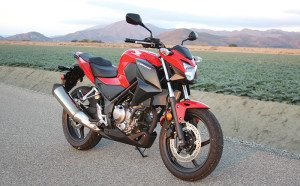
Having debuted as a high-tech single in 2011, the Honda held its own in our May 2011 250 shootout against a Ninja that was last upgraded in 2008, so it has received less radical changes in the race for small-bike bragging rights. Like its competition, Honda’s search for horsepower also led to a stroker strategy. By adding 8mm of up-down action with rod and crankshaft mods, the bike gained another 37cc, for a total of 286. And by combining some digital magic in the fuel injection map with the new hard parts, the 300 got a claimed 17 percent power increase over the CBR250R and snappier throttle response. Not bad for such a modest upgrade.
In our last head-to-head test, the CBR and Ninja performed well for quarter-liter machines, but weren’t impressive in the power department. That’s changed—the new models both have more oomph, with Honda still the king of low-end torque. It’s also stronger in the mid-range, and gets a good rush at around 8,500 rpm on the way to its 10,500 rpm redline, but still lacks enough reserve power at freeway speeds to feel comfortable for a long stretch. My derriere dyno tells me the Ninja has extended its supremacy in top-end power, as judged by the speeds it attains in fast traffic, and the real dyno confirms this. The low end is still soft—like sitting on a sailboat in the doldrums, you’re waiting awhile for something to happen. There’s also a vague feel in the new slipper/assist clutch, which makes starting out more difficult than with the torquey Honda. But things begin to happen above 5,000 rpm, and at nine grand or so it’s a ripper.
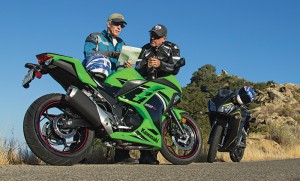
Both bikes roll on the same sized cast wheels, wear bias-ply IRC RX-01 tires, stop with dual-disc front and rear brakes with ABS, use the same sized (37mm) fork tubes in their non-adjustable front suspension, and sport single, linked shocks with preload-only adjustments. The suspensions work about the same, and are adequate for bikes in this power range. You feel most of the pavement imperfections, but the ride is stable and comfortable until the tarmac gets rough and ratty. Like their 250 ancestors, the 300s are both a hoot in the twisties, with the Kawasaki still being easier to hold on a line in faster corners.
The 6-speed transmissions in both machines are smooth and precise, making easy work of the frequent shifts required (especially on the Ninja) to keep them moving. Brakes are good too—plenty strong for bikes of this size, with ABS that doesn’t intrude until required. Vibration is an exception to all the sameness. The Ninja is sewing machine smooth at every rpm thanks to the vibe-damping front engine mounts fitted during its overhaul. Honda could take a lesson here, as the CBR seems buzzier as a 300 than it was as a 250. The vibration grows with engine speed, from a tingle in the hands to a buzz in the seat and pegs. Perhaps that’s why the Honda’s pegs have rubber inserts, while the Kawasaki gets away with bare steel.
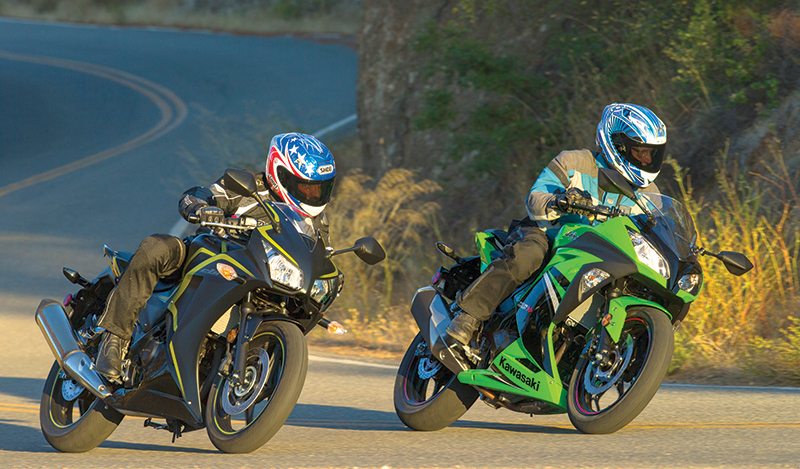
With seat heights approaching 31 inches and narrow waists, the 300s are accessible to most riders; Honda offers a one-inch lower seat to accommodate those who need to be closer to the ground. The bikes are small, so the bars and pegs are close by, but there’s plenty of room for an average-sized pilot without feeling cramped. In keeping with its sportier image, the Ninja’s pegs are higher and farther back, so taller riders beware. Seats are small, but comfortable; the pillions are best suited to leprechauns or 6-year-olds.
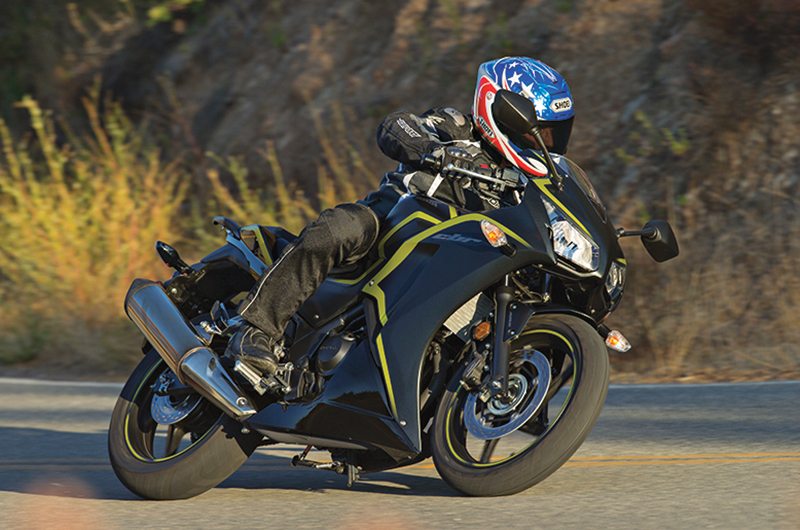
Hybrid instrument pods are similar as well, with analog tachometers and digital speedometers. Clocks, tripmeters and fuel gauges supplement the normal complement of indicators. The Ninja’s LCD panel displays an “Eco” indicator to indicate fuel efficiency when you’re riding sedately. Its turn signal indicators are too dim to see well in daylight, which made me the Bozo going straight with his turn signal flashing on several occasions.
The CBR repeats as the winner in the economy contest, besting the Kawasaki by more than 12 mpg throughout our test. To be fair, the Ninja begged to be revved, and I complied, but both were ridden as if they were stolen for the most part, which is what you do with these small machines. Small weight gains accompanied displacement increases, with the Ninja adding 7 pounds to the Honda’s single pound. In the service arena, the Kawasaki now sports a convenient spin-on oil filter while the Honda still uses an internal one. The CBR gains maintenance points for making the battery and air filter easily accessible beneath the seat, and for a much larger filter that should require less frequent attention.
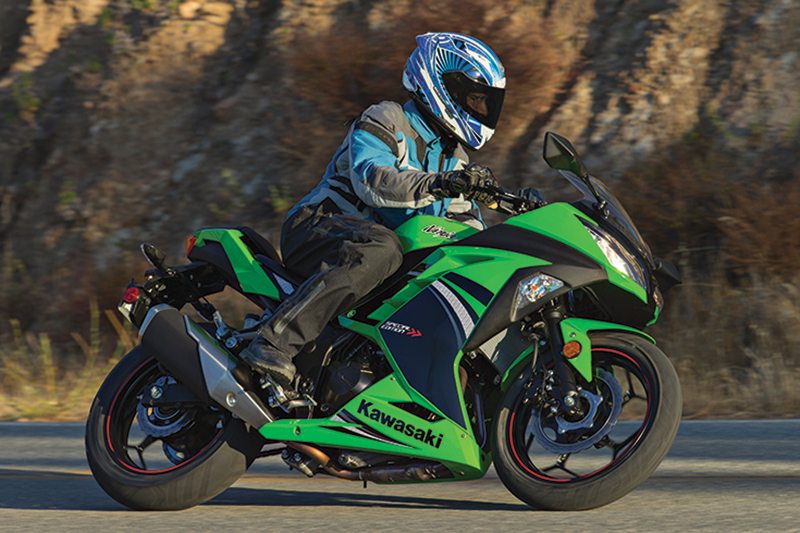
These 300s are a big step up from their quarter-liter ancestors, operating more like real sportbikes than wannabes. Though the Ninja gets the nod for most improved in power, comfort (less vibration) and rideability, the Honda remains a strong contender that scurries through the twisties and is easier to live with in town. Spinning to redline in third and fourth gears is the kind of experience that will sell the Ninja, while aficionados of low-end torque and steady power delivery will appreciate the Honda. The Kawi reminds me of the CB400 Four I rode to Chicago many moons ago—small, but happy to fly with traffic on the open road. The Honda channels my former CBR600 F2, which was the perfect balance of sport capability and commuter/sport-touring comfort. I couldn’t pick a favorite in our 250 comparo, and balancing the Ninja’s distinct power advantage against its $400 premium over the CBR (excluding the extra two bills for our test unit’s bling-only SE package) makes the choice even harder now. But it wouldn’t be fair to cop out twice, so my final answer is: Ninja. As much as I enjoyed the Honda’s torque and spunk, the Kawasaki has leaped ahead in performance and comfort, which makes it a winner for me. Now the question is…what will Honda do next?
2014 Kawasaki Ninja 300 ABS SE
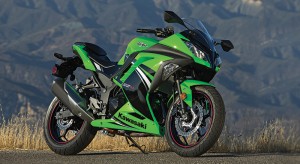
Base Price: $4,999 (2015 base model same)
Price as Tested: $5,499 (SE model, ABS)
Warranty: 1 yr., unltd. miles
Website: kawasaki.com
Engine
Type: Liquid-cooled, transverse, parallel twin
Displacement: 296cc
Bore x Stroke: 62.0 x 49.0mm
Compression Ratio: 10.6:1
Valve Train: DOHC, 4 valves per cyl.
Valve Insp. Interval: 12,000 miles
Fuel Delivery: Digital fuel injection w/ 32mm throttle bodies x 2
Lubrication System: Wet sump, 2.4-qt. cap.
Transmission: 6-speed, cable-actuated wet slipper clutch
Final Drive: O-ring chain
Electrical
Ignition: TCBI w/ digital advance
Charging Output: 280 watts @ 5,000 rpm
Battery: 12V 8AH
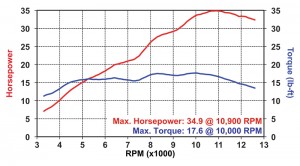
Chassis
Frame: High-tensile steel semi-double cradle
Wheelbase: 55.3 in.
Rake/Trail: 27 degrees/3.7 in
Seat Height: 30.9 in.
Suspension, Front: 37mm stanchions, no adj., 4.7-in. travel
Rear: Single shock, adj. for spring preload, 5.2-in. travel
Brakes, Front: Single 290mm disc w/ 2-piston floating caliper & ABS (as tested)
Rear: Single 220mm disc w/ 2-piston floating caliper & ABS (as tested)
Wheels, Front: Cast, 2.75 x 17 in.
Rear: Cast, 4.00 x 17 in.
Tires, Front: 110/70-H17
Rear: 140/70-H17
Wet Weight: 383 lbs. (as tested)
Load Capacity: 397 lbs. (as tested)
GVWR: 780 lbs.
Performance
Fuel Capacity: 4.5 gals.
MPG: 87 PON min. (low/avg/high) 45.0/51.5/59.2
Estimated Range: 232 miles
Indicated RPM at 60 MPH: 6,500
2015 Honda CBR300R ABS
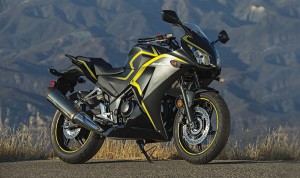
Base Price: $4,399
Price as Tested: $4,899 (ABS model)
Warranty: 1 yr., unltd. miles
Website: powersports.honda.com
Engine
Type: Liquid-cooled single
Displacement: 286cc
Bore x Stroke: 76.0mm x 63.0mm
Compression Ratio: 10.7:1
Valve Train: DOHC, 4 valves per cyl.
Valve Insp. Interval: 16,000 miles
Fuel Delivery: PGM-FI, 38mm throttle body
Lubrication System: Wet sump, 1.6-qt. cap.
Transmission: 6-speed, cable-actuated wet clutch
Final Drive: O-ring chain
Electrical
Ignition: Computer-controlled digital transistor w/ electronic advance
Charging Output: 340 watts @ 5,000 rpm
Battery: 12V 6AH
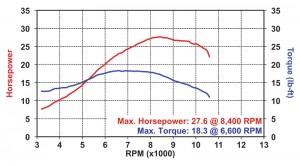
Chassis
Frame: Tubular-steel diamond double cradle
Wheelbase: 54.3 in.
Rake/Trail: 25.3 degrees/3.9 in.
Seat Height: 30.7 in.
Suspension, Front: 37mm stanchions, no adj., 4.7-in. travel
Rear: Single shock, adj. for spring preload, 4.1-in. travel
Brakes, Front: Single 296mm disc w/ 2-piston floating caliper & ABS (as tested)
Rear: Single 220mm disc w/ 1-piston floating caliper & ABS (as tested)
Wheels, Front: Cast, 2.75 x 17 in.
Rear: Cast, 4.00 x 17 in.
Tires, Front: 110/70-H17
Rear: 140/70-H17
Wet Weight: 362 lbs. (as tested)
Load Capacity: 368 lbs. (as tested)
GVWR: 730 lbs.
Performance
Fuel Capacity: 3.4 gals.
MPG: 87 PON mn. (low/avg/high) 64.0/64.3/72.0
Estimated Range: 219 miles
Indicated RPM at 60 MPH: 6,400

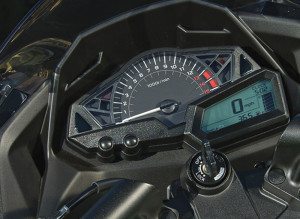
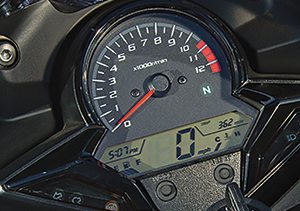
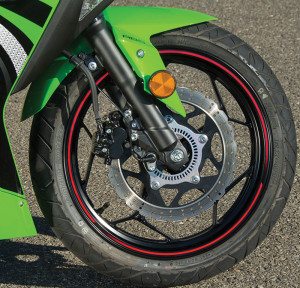
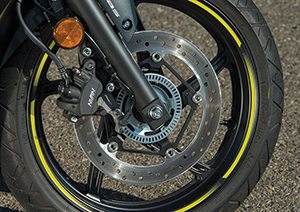
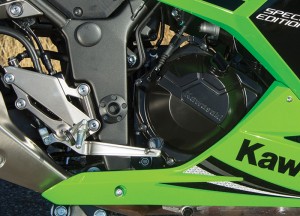
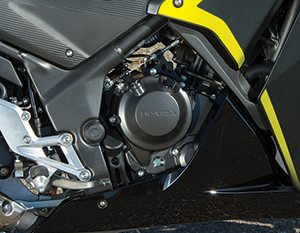







The CBR still uses an internal oil filter? That’s a deal breaker. Now that I have a bike with a spin on, I’d have a real hard time buying a modern bike without one.
Kawi smoother than Honda, what’s the world coming to? Personally I would prefer the Honda’s power characteristics, but they need to smooth it out apparently, as well as a spin on.
In Australia Kawasaki 300 is outselling by far every other bike in the country. It has cornered the market in the restricted learner legal market. At the moment it is the bench market in learner legal motorcycles.
More vibration? The 250R already had rather intrusive vibration above 6000 RPM. It is a fun bike, but I can’t imagine having even more vibration to contend with. Touring grips and aftermarket seats only take you so far. Even with rubber mounted pegs vibration is still a problem in that area. I really expected Honda to step up to the plate and deal with the vibration issue. I am very disappointed to hear it has actually gotten worse. Being so far down on horsepower Honda really needed to knock it out of the park in every other category (particularly with the YZF-R3 on the way).
Well said Bill. Come on Honda! It should be like that fabulous 500 twin you just made. If you haven’t rode a cb500f or x you should. Smooth as glass at any rpm.
i ‘m a big fan of cbr
Just wondering if anyone 6 foot tall has rode either bike. What was your comfort level. Looking and have it narrowed down to one of these two
I’m 5-11. 150 pounds and I have no problem with the ninja 300. But it also has a more aggressive seating position than the R3 or honda which I perfer that because it’s easier to get in closer with the tank but if you were looking for something more comfortable go with the R3
I’m 6 foot tall and have 2014 300 R Ninja. It is better than 250 as far as seating and ridding is better for comfortable but never rode R3.
I’m old biker age 59 and have been riding for 48 years. I like small bike not so heavy to roll around..
I ride town most of the time so no need for bigger bike and I also have big bike but like 300 to get round town with. I load bike in back of my mini van and loads easy no problem at all even at my age..
Still best bike for the money..
Lee
I purchased a 2015 Honda CBR 300 while my sister purchased a 2014 Kawasaki Ninja 250….if I must say so myself, I love both bikes, but the Ninja has more power!
Missing on the R3 is the clipons have a 1.5 inch riser built in. Should you add an inexpensive typical clip on, you lose one inch of height and you will be leaning on the elbows and wrist. Ten years ago I would have done that first, but as I mature, I appreciate the more upright but still lean forward design of the R3. That said, I really like the Ninja 300 for all the reasons a young man would buy a sportbike. If you want a feel for a 600, then buy the Ninja over any of the others, and its fuel tank allows for a full day of riding without constantly stopping for petrol. The typical Honda rhetoric is prevalent in the results. It is so wonderful in the twisties, when it should have said it is slower than a scooter. I would never recommend the sport bike version, but the naked version would be perfect for a first time rider with its mild manners and lack of HP.
If I ever got a motorcycle, it would be a bullet bike. Thanks for the heads up about looking for a bike that doesn’t have an internal oil filter. The thing I’m wondering about is the life span of each bike? I know there are several factors (commuting, two vs one rider, ride length), but what is a good estimate for both bikes? http://www.hondadirectline.com
I have Kawasaki Z 300 ABS. I bought it with 19 900 Km on clock. I am just a weekend rider and for 8 months don about 700 km. Longest ride I have made was 130 km tat toked me 2 hours because of the curvy hill road but my ass was hurting and especially after the ride home… But the bike is doing very well and I have the same question how long will it survive. Ans I always ride with my wife with me I am 80 kg and she 50 Kg. so will it last for another 20 000 km?